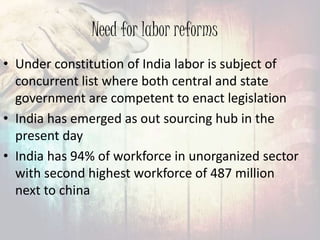Labour reforms ultimate
- 2. Introduction Labor Reforms are made to protect the common interest of workers. For those in the industrial sector, organized labor unions fight for better wages, reasonable hours and safer working conditions. The labor reforms led efforts to stop child labor, provide health benefits, job security and improve the living conditions. It not only benefit the labors but also contribute in the development of economy. Who is a labor? Is a person who provides services for wages as distinguished from those rendered by entrepreneurs for profits.
- 3. Present situation An estimated 90 per cent of India’s labor market is informal. Why does this matter? Inefficient labor laws constrain firm development and economic growth; employers rely on the informal economy because the costs of formalization are too high; meanwhile workers in the informal economy are excluded from basic protections.
- 4. Need for labor reforms • Under constitution of India labor is subject of concurrent list where both central and state government are competent to enact legislation • India has emerged as out sourcing hub in the present day • India has 94% of workforce in unorganized sector with second highest workforce of 487 million next to china
- 5. Impact of labor reform implementation Labor reforms if not implemented soon It would take a hit on India as an investment destination. It will lead to great economic loss. And the make in India campaign may suffer. Strikes and lockdown has been reduced
- 6. LABOR REFORMS 2104 - 15 • PM Modi had unveiled the most awaited labor reforms emphasising that ease of business is possible when “MAKE IN INDIA” is successful thereby making India a manufacturing hub. • “Shramev Jayate” should have equal power as “Satyamev Jayate” so as to develop the country.
- 7. Universal Account Number (UAN) •The UAN will allow collation of accounts and viewing of updated PF accounts. •The UAN would be portable throughout the working careers of members, this scheme would enable 41.7 million employees to make their Provident Fund account portable, hassle-free and universally accessible. •Companies does not have to maintain separate PF accounts for each labor.
- 8. Apprentice Protsahan Yojana • Government to reimburse 50% of the stipend paid to apprentice during first 2 years of training . • Setting up of central institute for vocational training(13 jan 2015) • This will improve the quality of labour market in India giving companies value for money. • Under this scheme, Industrial Training Institutes have total of 34 lakh seats for students. • This will increase the morale and dignity of labor and remove inferiority amongst them.
- 9. Shram Suvidha Portal • Allots Labour Identification number to nearly 6 lakh firms. • Allows e-filing of compliance reports. • Unique account numbers for members of the EPFO(Employee PF org.),ESI(Employee’s state insurance). • company can now register online at the Shram Suvidha portal and file a self-certified single compliance report for 16 Central labour laws. • Sharply streamlining compliance process. • Elimination of bureaucracy red-taping in turn saving time. • Reducing the Entry barrier for new companies.
- 10. RANDOM INSPECTION SCHEME • Elaborating on steps to end the inspector raj -- harassment by officials, Modi said a transparent labor inspection scheme is being developed to check arbitrariness. • While so far the units for inspection were selected locally without any objective criteria. • A computerized list of inspections will be generated randomly on predetermined objective criteria and complaints-based inspection will also be determined centrally based on data and evidence. There will also be provision of Emergency List for inspection of serious cases. • Now computer draw will decide which inspector (labour) will go for inspection to which factory and he will have to upload his report online in 72 hours. • These facilities are what is called as minimum government, maximum governance • It will lead to reduction of corruption which is most important if make in India campaign successful
- 11. Hire and Fire schemes • Regardless of the size of the company all workers must be on the master roll of the company i.e. threshold of duration (240days) and size(100 workers) has been removed. • Workers counsel should be formed in every enter price regardless of size. With worker representative on board elected by the people with equal power as other members. • The limit for intrinsic informal worker hiring is reduced to 5 % • If the worker is sacked then he will have to be given benefits such as DA , PF, severance pay i.e. 45days salary for every year of work. • Since all workers are protected hence will lead to economic growth. • Will lead to right sizing of company. • For seasonal industries (textile )can hire workers for minimum 180 days if goes beyond this have to hire for the whole year. • Both industrial and trade unions have welcomed this step.
- 12. Child labor • Under previous laws, child labor is not a punishable offence in some "non-hazardous" sectors such as farming. • It was argued that there should not be any discrimination on working in hazardous or non-hazardous industry in terms of the ban. • Child Labor Act to bring it in tune with the Right To Education (RTE) Act, which makes education compulsory for all children up to the age of 14. • Employing a child under 14 for any work -- hazardous or non- hazardous -- will be an offence punishable with imprisonment up to two years or a fine up to Rs 50,000 or both, an increase from the current one-year jail or Rs 20,000 punishment. Repeat offenders can be imprisoned for up to three years.
- 13. The impacts of new labour reforms • The above reforms will accelerate “MAKE IN INDIA” campaign. • Encourage the entrepreneurs. • Will encourage investment from India and abroad . • Will reduce unemployment. • Will eliminate leakages from economy. • Will increase income of govt.(which can be used to reduce deficit) • Increase in skilled labour. • Will contribute to growth of GDP and decrease in Inflation in country.
- 14. Conclusion • The above labour reforms will improve skilled labour market increasing the employment simultaneously increasing quality of production meeting the global standards and will in turn increasing the prosperity of country and make India a attractive destination to investors.













